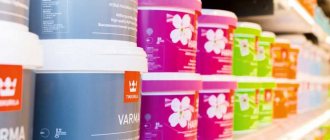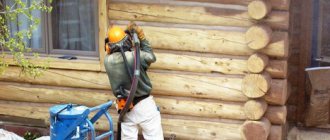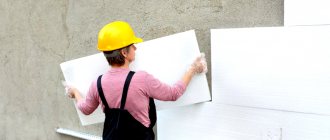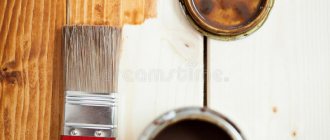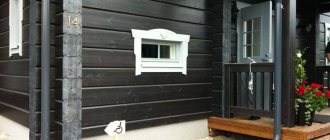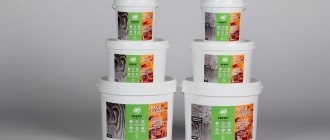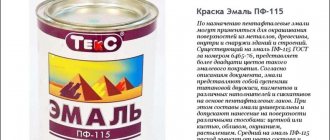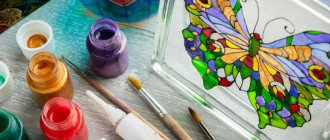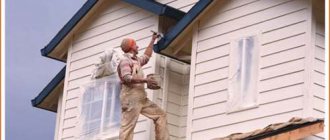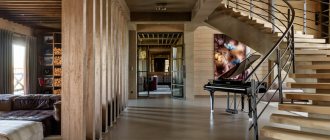Houses made of timber and logs are now very popular. They are chosen because of their stylish appearance, warmth and environmental friendliness. Living in a wooden house gives you a feeling of unity with nature. Despite the fact that there are modern building materials, wooden houses are in high demand. The reason is a number of advantages that such buildings have.
Advantages of houses made of timber and logs
Wood, unlike many other materials, has the ability to create and maintain a unique indoor climate. There is an expression - “walls breathe.” It's just about wooden walls.
Conifers have the ability to disinfect the air. Essential oils have a positive effect on the human body. Wooden houses always have a comfortable temperature. In summer it is cool there, and in winter the walls retain heat well. Heat loss from wooden walls is low compared to other materials.
Wooden houses are durable, so their popularity is growing every year. In the old days, in Rus', most houses were built from wood. Wooden houses are beautiful and demonstrate to others the respectability of the owner.
With all the advantages of wooden buildings, one cannot fail to mention their disadvantages. The tree is exposed to dampness, can dry out from the sun, and is attacked by fungi, mold and harmful insects. To avoid all these troubles, wood must be protected. There are various compositions for this:
- Primers. They penetrate into the wood, create a protective layer, and increase the adhesion of the paint to the surface. After priming, painting the surface is much easier.
- Antiseptic compounds. Their task is to protect wooden surfaces from mold and mildew.
- Stains. These are special compounds that can be used to give wood different shades.
- Paints. They create a durable surface layer; the difference in shades and structures allows the paint to be used in rooms with different purposes.
- Lucky. There are colored and colorless. Varnishes protect wood, improve its appearance, increase wear resistance, and extend its service life.
The compositions can be combined with each other. For example, the surface of the walls is first primed, then painted; varnish is often applied after staining. There are also modern compositions for wood - enamel impregnations. With their help, you can tint wood and protect it from negative atmospheric influences.
Professional coloring services
Most property owners tend to save money by not inviting professionals to paint. However, the high-quality result created by specialists will save not only time, but also money. They will tell you which product is best suited for the job and will last longer. You can be sure that the result will be beautiful and durable. The cost of services is often calculated based on the area of the room, calculated by square meters.
However, the high-quality result created by specialists will save not only time, but also money.
Before painting the logs inside the house, the surface should be thoroughly prepared. And also pay special attention to the choice of product. It should not only be beautiful in appearance, but also protect the surface from external factors.
How to choose paint for a wooden house
The paint must be moisture-resistant and abrasion-resistant! If you decide to paint wooden walls, remember that there are many colors and each type has its own properties.
- Oil paints. Provide shine and make the surface glossy. Walls coated with oil paints are easy to clean and do not allow moisture to pass through. Disadvantages of oil paints: they take a long time to dry and smell unpleasant for several days after application.
- Acrylic paints. They are easy to apply, have virtually no odor, and do not fade. They are easy to wash.
- Alkyd paints and enamels. With their help you can get a durable glossy finish. The paints are durable, but when applied they emit an unpleasant odor for some time.
- Water-dispersion paints. These paints dissolve with water, not solvents, and are therefore considered safe. They do not have an unpleasant odor and do not fade for a long time. However, it is very difficult to wash a surface coated with water-dispersion paints.
- Silicone paints. The most expensive of all paint options, but at the same time they are suitable for any room, do not fade for a long time, do not crack, and are easy to clean.
No. 7. Drywall
Drywall for cladding wooden walls is used quite rarely for obvious reasons. Its use is justified when it is necessary to erect a partition , hide communications , or when the surface of the wood has significant defects. Installation of plasterboard sheets is carried out on a frame , for the construction of which you can use a wooden beam or a metal profile; you cannot do without gaps near the ceiling and floor.
Finishing with plasterboard can only be done after the house has completely settled and provided that the room is heated in winter. Gypsum is a sensitive, fragile material that can become severely deformed when walls shrink or undergo sudden temperature changes. To extend the life of such a finish, you can use a floating frame , and glue all sheet joints and corners with a reinforcing polymer mesh . To decorate the walls in the kitchen and bathroom, you must use moisture-resistant plasterboard.
Protective and decorative varnishes
Varnishes are also used to cover walls in a wooden house. This is an excellent coating that protects and improves the appearance of the surface. There are different types of varnishes, each with its own purpose.
Acrylic varnish contains organic or water-based polyacrylates. The environmentally friendly composition allows the use of acrylic varnishes to cover indoor walls and furniture. produces DecoGuard Universal Varnish. Designed for external and internal work on stone, brick, concrete, various decorative tiles and other finishing materials. Creates a decorative transparent coating that emphasizes the texture of the material. Used to create a “wet stone” effect on any type of mineral substrate. Can be used for protection and decorative treatment of wooden surfaces, decorative plasters and wallpaper. Can be tinted with water-based and universal pigment pastes.
Polyurethane varnish is water-based and has high strength and abrasion resistance. Polyurethane varnish is odorless, so it is perfect for applying to wooden walls inside the house.
produces DecoGuard High-strength polyurethane varnish.
It is intended for covering floors and other surfaces that experience significant mechanical loads. Can be used to cover brick, artificial and natural stone. Creates a decorative transparent coating that emphasizes the texture of the material.
Color selection: recommendations
When choosing what color to paint walls, ceilings and other structural elements inside a wooden house, you need to consider:
- interior style. For the “Scandinavian” type, white or any light pastel colors are suitable. Modern allows for contrasting bright colors and the use of several compatible shades. Classic implies a natural light tone or color that is in harmony with the shade of wood, matching other details of the furnishings. When completely painting all surfaces of the room, the choice is arbitrary, corresponding to the style;
- harmony of the chosen color with a shade of wood, natural or tinted;
- opportunities to visually increase/decrease/divide the space of the room. To visually expand or lengthen a room, you should use light and contrasting colors.
If painting the timber of a wooden house is used for zoning, it is logical to select a shade in accordance with the decor of the zone (furniture, appliances, bright decorative elements).
Paints and enamels for finishing wooden walls
Water-soluble paints are suitable for painting walls inside the house. Such paints do not emit harmful toxic substances either during the application process or during the operation of the premises.
To choose the right paint for indoor walls, you need to keep several factors in mind. First, it is important to understand what kind of room you are going to paint. If you spend a lot of time in it, it is important that the paint is environmentally friendly and has vapor permeability. If you need to paint the kitchen and it is located inside the house and not in a separate room, then it is better to buy paint with high wear resistance, since the kitchen walls have to be washed quite often. For the bathroom and laundry rooms you need paint with increased moisture resistance.
Acrylic paints are water-based and can provide wood with reliable protection and rich, lasting colors. Acrylic paints have high adhesion and do not deform during use.
produces PaintGuard Interior Paint.
Using PaintGuard interior paint, you can achieve the best results when decorating the interior of your home. Therefore, this paint is very popular among those who do repairs. Designed for high-quality painting of walls and ceilings inside dry rooms with normal humidity (living rooms, corridors, offices) on concrete, plastered, plasterboard, brick and wooden surfaces.
produces PaintGuard Universal Enamel.
Acrylic enamels require a minimum amount of time to dry completely. On average, drying takes 3 – 4 hours. Thanks to this, the speed of work increases significantly. PaintGuard Universal Enamel does not emit any strong chemical odors. It is comfortable to work with even people who are hypersensitive to odors and prone to allergic reactions.
produces PaintGuard Antibacterial Enamel.
This is an acrylic water-dispersion enamel for interior and exterior use. Due to its antibacterial properties, enamel can provide high-quality coating in areas where microflora is likely to develop (medical and preventive institutions, bathrooms and kitchens). Antibacterial enamel is also excellent for painting public spaces and crowded places where viral epidemics and diseases can occur and spread: markets, train stations, stadiums, subways, cinemas, zoos, hotels.
Types of funds
Coverings for lining are divided into two main groups: protective and finishing (decorative). The first group includes compounds that have different working functions. Some are impregnations, others are covering materials. Both of them create a barrier against negative external factors.
Impregnations suitable for lining:
- covering soil;
- stain;
- wax;
- oil;
- specialized impregnation;
- antiseptics;
- drying oil;
- bleach;
- fire retardant
Several layers of stain with and without the addition of toners look different Source elka-palka.ru
Covering finishing materials act as a decorative layer, simultaneously serving as both protection and decoration. When there is no desire to cover up the wood pattern and its color, the coating composition is chosen from among the following translucent options:
- glossy or matte clear varnishes;
- tinted clear varnishes;
- translucent varnishes;
- wax;
- aqualak on acrylic;
- translucent enamel;
- decorative azure.
Brushed lining is coated with water-soluble transparent varnish Source 1povagonke.ru
For other cases in which the natural color, texture and pattern of the board are unimportant, the lining inside the house is treated using covering materials. These include:
- acrylate, acrylic paints;
- oil paints;
- water-based paints.
Painting new lining with acrylic paint - the first layer of light green color Source sparta-stroy.ru
Wax belongs to the group of coating materials and impregnations. It all depends on the technology and the thickness of the applied layer. The degree of gloss of the coating depends on the duration and technique of polishing during waxing. In this case, wax can be called a coating material. The longer the procedure is carried out, the more the working wax surface approaches gloss. The less and less intensive grinding is done, the more the matte structure of the wax coating is preserved.
Impregnations for wood
Impregnations are water-based or other-based substances that penetrate deep into the material. They improve the performance characteristics of wood. With the help of impregnations, you can emphasize the natural beauty of wood and imitate other types of wood. Impregnation, unlike paints, does not hide the natural texture of wood and does not form a film that is noticeable upon tactile contact. If desired, you can give the wood a glossy look or make the surface matte. produces DecoGuard Protective and decorative impregnation with beeswax.
It creates a translucent, decorative coating that emphasizes the texture of the wood. Effectively protects wood from all types of atmospheric influences, UV rays and biological damage from mold fungi (including blue fungi), algae and other microflora. It is recommended to use it as a primer layer before varnishing a wooden surface, which significantly increases the strength and durability of the coating and reduces varnish consumption by 10-15%. Dries quickly and has no odor. Safe for people and animals.
releases DecoGuard Impregnation-enamel for updating old wood.
Acrylic water-dispersion antiseptic covering impregnation for old wood with the properties of an enamel coating. It is used indoors and outdoors for decorating and protecting wooden structures and products (preliminary removal of old paint and varnish is recommended). Decorative impregnation is intended for painting old darkened wood and, if desired, changing the color of new wood, further protecting it from all types of atmospheric influences: UV rays, humidity, biological damage by mold fungi (including blue mold), algae and other microflora.
Material calculation
Before purchasing paints and varnishes, you need to calculate the required amount of product. For ease of understanding, an example of a calculation is given based on varnishing prepared parquet.
For a room with a floor area of 15 square meters, therefore, you will need
- water-based varnish 15 x (100…120) = 1500…1800 g or
- alkyd varnish 15 x 80 = 1200 g.
Calculations will be greatly simplified using special calculators.
The amount of primer, stain, impregnation and other things is calculated in the same way. When making calculations, it is important to reserve at least 10% for unforeseen circumstances or possible problems with some of the materials.

